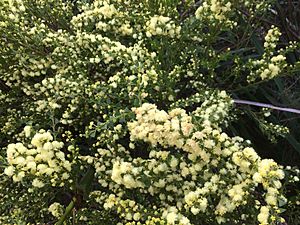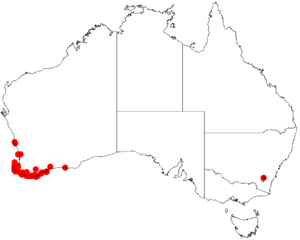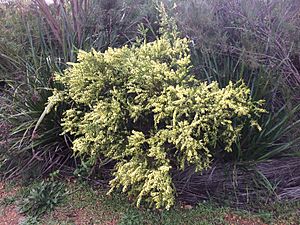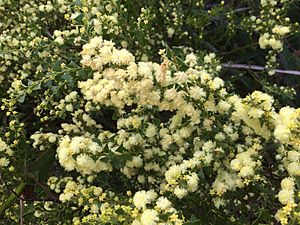Shark tooth wattle facts for kids
Quick facts for kids Shark tooth wattle |
|
|---|---|
 |
|
| A. littorea flowers and foliage | |
| Scientific classification | |
| Genus: |
Acacia
|
| Species: |
littorea
|
 |
|
| Occurrence data from AVH | |
The shark tooth wattle, also known by its scientific name Acacia littorea, is a type of bushy plant. It belongs to the large group of plants called Acacia and is part of a smaller group within it known as Phyllodineae.
Contents
What Does the Shark Tooth Wattle Look Like?
This bushy plant has a strong smell and usually grows to be about 0.5 to 3 meters (1.6 to 9.8 feet) tall. It has bright yellow flowers that bloom from August to November.
Its branches are smooth and have clear ridges. The green, strong-smelling leaves, called phyllodes, point upwards. They have a cool shape, like a shark's tooth, which is where the plant gets its common name! These leaves are typically 7 to 17 millimeters (0.28 to 0.67 inches) long and 5 to 15 millimeters (0.20 to 0.59 inches) wide.
The flowers grow in round clusters, with each cluster having 8 to 15 pale-yellow flowers. After the flowers, the plant grows long, thin seed pods that are blackish to yellowish. These pods are about 6 centimeters (2.4 inches) long and 2.5 to 3 millimeters (0.098 to 0.118 inches) wide. Inside the pods, you'll find shiny brown, oval-shaped seeds, each about 2.5 to 3 millimeters (0.098 to 0.118 inches) long.
How Was This Plant Named?
The shark tooth wattle was first officially described by a botanist named Bruce Maslin in 1978. He wrote about it in a science journal called Nuytsia.
The very first sample of this plant that scientists studied was collected by Bruce Maslin himself. He found it near the coast of Princess Royal Harbour in Albany in 1975.
This plant has had a few different names over time, like Acacia dolabriformis and Mimosa decipiens. It is also closely related to another plant called Acacia truncata.
Where Does the Shark Tooth Wattle Grow?
The shark tooth wattle is native to certain areas in Western Australia. You can find it mostly in the South West, Great Southern, and Peel regions. Most of these plants grow from Busselton in the west all the way to Bremer Bay in the east. There's also a small group of them growing on Rottnest Island.
This wattle loves to grow on sandy coastal dunes and in areas with limestone soil. It's often found in heathland areas and can sometimes be the most common plant there.
Growing Shark Tooth Wattle in Your Garden
You can buy shark tooth wattle as seeds or as small plants. It grows best in a sunny spot with soil that drains water well, making it a great choice for gardens near the coast.
This plant can handle dry weather (it's drought-tolerant) and even some cold (it's frost-tolerant). It grows quickly but doesn't live as long as some other plants. It's useful for stopping soil from washing away (erosion control) or for creating a barrier against the wind.



